View in other NatureServe Network Field Guides
NatureServe
Montana
Utah
Wyoming
Idaho
Wisconsin
British Columbia
South Carolina
Yukon
California
New York
Shaggy Dwarf Morning-glory - Evolvulus nuttallianus
Native Species
Global Rank:
G5
State Rank:
S3S4
(see State Rank Reason below)
C-value:
4
Agency Status
USFWS:
USFS:
BLM:
External Links
State Rank Reason (see State Rank above)
Evolvulus nuttallianus is fairly common in south-central and south-east Montana, but appears to be undercollected in herbarium and database records.
- Details on Status Ranking and Review
Population Size
ScoreCE - 250 - 10,000 individuals
Range Extent
ScoreF - 20,000-200,000 sq km (~8,000-80,000 sq mi)
Area of Occupancy
ScoreD - 6-25 4-km2 grid cells
Number of Populations
ScoreB - 6 - 20
Number of Occurrences or Percent Area with Good Viability / Ecological Integrity
ScoreB - Very few (1-3) occurrences with excellent or good viability or ecological integrity
Environmental Specificity
ScoreC - Moderate. Generalist or community with some key requirements scarce
Threats
ScoreD - Low
CommentNo known threats.
General Description
Plants:
Evolvulus nuttallianus is a woody-based perennial herb, 7 to 20 centimeters tall and densely covered with brownish or grayish hairs (Lesica et al. 2012; McGregor et al. 1986). Stems are erect or ascending (McGregor et al. 1986).
Leaves: Leaves are alternate and densely covered with hairs, like the stems. They are narrowly lance-shaped or inversely lance-shaped and 8 to 15 centimeters long, with short or absent petioles (Lesica et al. 2012; McGregor et al. 1986).
Inflorescence: The flowers are borne singly in the leaf axils along the length of the stem, upon a 1 to 4 millimeter peduncle with two small bracts at the base (McGregor et al. 1986; Lesica et al. 2012)
(Contribution of Lesica et al. adapted from
Lesica et al. 2012. Manual of Montana Vascular Plants. BRIT Press. Fort Worth, TX)
Phenology
Flowers May to July (McGregor et al. 1986).
Species Range
Montana Range
Range Descriptions
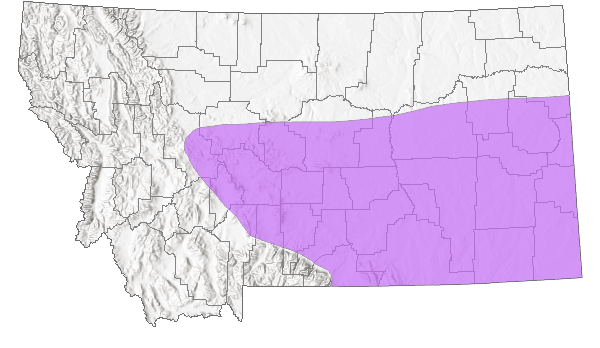
 Native
Native
Range Comments
MT, SD south to AZ, TX and TN (Lesica et al. 2012. Manual of Montana Vascular Plants. BRIT Press. Fort Worth, TX).
Observations in Montana Natural Heritage Program Database
Number of Observations: 51
(Click on the following maps and charts to see full sized version)
Map Help and Descriptions
Relative Density
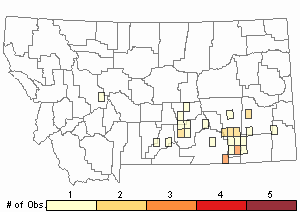
Recency

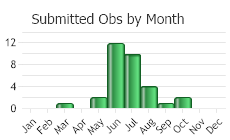
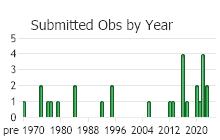
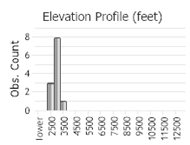 (Observations spanning multiple months or years are excluded from time charts)
(Observations spanning multiple months or years are excluded from time charts)
Habitat
Ecology
In a Colorado study, 3 species of grasshoppers fed on Evolvulus nuttallianus out of 14 grasshoppers studied (Ueckert et al. 1972). This plant made up 10% of the diet of Melanoplus foedus and 1% of the diets of M. angustipennis and M. confusus. Dicot plants comprised over 60% of the diet for these three grasshoppers and less than 20% of the diet for all others studied, which ate primarily grasses.
Bison (Bos bison) were been documented grazing E. nuttallianus in a Colorado experiment, though grasses made up the majority of their diet (Peden et al. 1974).
Reproductive Characteristics
Flowers: The sepals are narrowly lance-shaped, quite hairy, and 3 to 5 millimeters long (McGregor et al. 1986; Lesica et al. 2012). They surround the light lavender corolla, which forms a 4 to 7 millimeter long tube (Lesica et al. 2012). The anthers are 1 to 2 millimeters long, upon filaments that are twice as long (McGregor et al. 1986).
Fruit: The fruit is an egg-shaped capsule without hairs, similar in length to the sepals. Inside are two (sometimes one) smooth brown seeds (McGregor et al. 1986).
(Contribution of Lesica et al. adapted from
Lesica et al. 2012. Manual of Montana Vascular Plants. BRIT Press. Fort Worth, TX)
Stewardship Responsibility
References
- Literature Cited AboveLegend:
 View Online Publication
View Online Publication Lesica, P., M.T. Lavin, and P.F. Stickney. 2012. Manual of Montana Vascular Plants. Fort Worth, TX: BRIT Press. viii + 771 p.
Lesica, P., M.T. Lavin, and P.F. Stickney. 2012. Manual of Montana Vascular Plants. Fort Worth, TX: BRIT Press. viii + 771 p. McGregor, R.L. (coordinator), T.M. Barkley, R.E. Brooks, and E.K. Schofield (eds). 1986. Flora of the Great Plains: Great Plains Flora Association. Lawrence, KS: Univ. Press Kansas. 1392 pp.
McGregor, R.L. (coordinator), T.M. Barkley, R.E. Brooks, and E.K. Schofield (eds). 1986. Flora of the Great Plains: Great Plains Flora Association. Lawrence, KS: Univ. Press Kansas. 1392 pp. Peden, D.G., G.M. Van Dyne, R.W. Rice, and R.M. Hansen. 1974. The trophic ecology of Bison bison l. on shortgrass plains. Journal of Applied Ecology 11(2):489-498.
Peden, D.G., G.M. Van Dyne, R.W. Rice, and R.M. Hansen. 1974. The trophic ecology of Bison bison l. on shortgrass plains. Journal of Applied Ecology 11(2):489-498. Ueckert, D., Hansen, R., and C. Terwilliger, Jr. 1972. Influence of Plant Frequency and Certain Morphological Variations on Diets of Rangeland Grasshoppers. Journal of Range Management 25(1): 61-65.
Ueckert, D., Hansen, R., and C. Terwilliger, Jr. 1972. Influence of Plant Frequency and Certain Morphological Variations on Diets of Rangeland Grasshoppers. Journal of Range Management 25(1): 61-65.
- Additional ReferencesLegend:
 View Online Publication
View Online Publication
Do you know of a citation we're missing? King, L.A. 1980. Effects of topsoiling and other reclamation practices on nonseeded species establishment on surface mined land at Colstrip, Montana. M.Sc. Thesis. Bozeman, MT: Montana State University. 129 p.
King, L.A. 1980. Effects of topsoiling and other reclamation practices on nonseeded species establishment on surface mined land at Colstrip, Montana. M.Sc. Thesis. Bozeman, MT: Montana State University. 129 p. Lesica, P., M.T. Lavin, and P.F. Stickney. 2022. Manual of Montana Vascular Plants, Second Edition. Fort Worth, TX: BRIT Press. viii + 779 p.
Lesica, P., M.T. Lavin, and P.F. Stickney. 2022. Manual of Montana Vascular Plants, Second Edition. Fort Worth, TX: BRIT Press. viii + 779 p.
- Web Search Engines for Articles on "Shaggy Dwarf Morning-glory"





